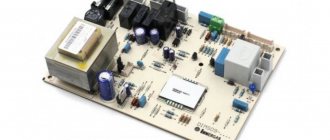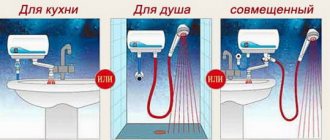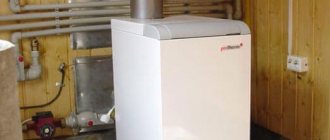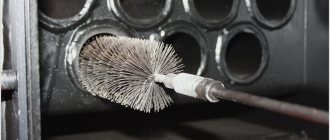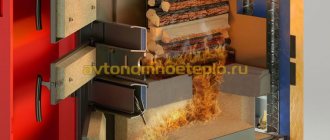Owners of private houses are often faced with the question: what is the optimal temperature to set on a gas boiler to keep it warm and economical? Of course, it will be impossible to clearly answer this question using numbers, because there are quite a lot of unknown variables: how many m² need to be heated, how well the house itself is insulated, what are the weather conditions outside, the boiler model and the degree of wear and tear of the entire heating system.
Therefore, the best solution would be to turn to the services of specialists who will not only conduct a thorough analysis, but also set up the automatic heating boiler themselves for maximum efficiency at low fuel costs.
But we can give general recommendations. After the experiments, we can say for sure that at the minimum temperature the gas consumption will be the highest. Why? Read on.
Maximum and minimum temperature of a gas boiler: which is better?
It is worth mentioning that for the calculation we took an ordinary wooden house with two rooms with a total area of 40 m². The quality of insulation is average, the boiler operates with a capacity of 24 kW. It is suggested that rooms should be heated to 21 degrees Celsius.
40 degrees
The most economically ineffective mode. Firstly, the boiler will underheat the rooms by about a degree to one and a half degrees. Because of this, the pump and burner will work constantly, which will lead not only to excessive gas consumption, but also to increased power consumption. Measurements show that electricity may be needed about 3 times more than at 70 degrees! Therefore, if there are problems with the power supply or the boiler is powered by a generator, you should refrain from this mode.
In this mode, the batteries begin to cool down literally after a few hours. It is also worth noting that with high wear and tear of the heating system, there is a high probability of condensation forming, which harms the boiler.
50 degrees
Typically, with such settings, the boiler shows the lowest gas consumption, but in this case the circulation pump works almost without stopping. Due to the high price of electricity, this mode is more expensive than the next.
The batteries take much longer to cool down, the boiler completely warms the room to the required temperatures.
60 degrees
Optimal settings for most boilers. At this coolant temperature, more gas is required than at 50 degrees, but the pump runs less often. The room is completely heated, the batteries take a long time to cool down, and the total costs are lower than other modes.
70 degrees
Even less electricity is required than at 60 degrees, but much more gas is needed. Although at first glance it seems that such settings are more profitable, the danger lies elsewhere. In this mode of operation, the batteries will begin to heat up, even when the boiler is turned off. Thus, temperature fluctuations in the room are possible, which will negatively affect not only comfort, but also the condition of the entire heating system, in particular the pipes.
80 degrees and above
It is not recommended to set such settings. Firstly, such settings are needed in severe frosts if you live in the northern regions of the country. Secondly, due to exposure to high temperatures, pipes quickly become unusable, and an unpleasant odor may appear.
Factors that have the greatest impact on the life of a gas boiler
Heat exchanger material
The most common and inexpensive to manufacture is a steel heat exchanger. The wall thickness of steel heat exchangers does not exceed 3-5 mm, which, even when using purified coolant, leads to an emergency after 10-15 years of use. In addition, the likelihood of a steel heat exchanger burning out is much higher.
The cast iron heat exchanger is made with walls several times thicker; the metal itself is heat-resistant and corrosion-resistant. Potentially, the service life of cast iron heat exchangers can reach 50 years.
The most unpopular due to their even higher cost or technical impossibility of installation are copper heat exchangers. Despite its relative resistance to corrosion, copper, like steel, is characterized by the likelihood of burning out. Fortunately, multiple safety systems on expensive boiler models that use copper heat exchangers are almost guaranteed to prevent burnout. However, long service life of copper elements can only be achieved with regular maintenance.
How to flush the heat exchanger of a gas boiler and extend its life
Burner type
Atmospheric gas burner.
There are two types of burners:
- Atmospheric - used in boilers with an open combustion chamber with natural draft. Boilers with atmospheric burners accumulate significantly more soot and other combustion products, which not only requires more careful maintenance, but also slightly reduces service life.
- Inflatable (turbocharged) - used in boilers with a closed combustion chamber with natural draft through a coaxial (side) chimney or with forced draft provided by a fan or turbine. Combustion products are more efficiently released into the atmosphere and do not affect the operation of the boiler, and fans and turbines in most models have a long service life.
Thanks to more efficient combustion (longest possible cycle with the smallest possible flame), burners with the ability to modulate the flame extend the life of the boiler.
Automation
More expensive models of gas boilers are equipped with multifunctional automation, which will not only promptly warn about the condition of the boiler, but will ensure the most efficient operation of the boiler. By preventing emergency situations, automation with the functions of self-diagnosis, prevention of overheating and freezing, gas control, auto-ignition, and protection against blocking of the circulation pump significantly extends the life of the gas boiler.
However, for the correct operation of such automation, a voltage stabilizer and a UPS (uninterruptible power supply) are recommended.
Boiler cost and production technology
Prices for models from well-known European and Japanese manufacturers are, for the most part, quite justified, since they use more durable and reliable alloys, protection and insulation technologies, which affects not only efficiency, but also reliability and safety of operation.
terms of Use
The most common mistake is choosing an overly powerful gas boiler, when, due to the rapid heating of the coolant, it constantly turns on and off. This operating mode threatens not only higher gas consumption, but also a significant reduction in service life.
Also, the life of a gas boiler, or rather its heat exchanger (especially steel or copper), largely depends on the coolant. Using contaminated water promotes the formation of scale, oxidation and corrosion inside.
Heat exchanger of a gas boiler in section. The use of contaminated coolant and lack of regular cleaning led to serious consequences: serious overheating and almost complete clogging.
How to choose a water softener for a gas boiler and extend the life of the heat exchanger
In conclusion , we can say that the manufacturer’s forecast regarding the service life of a gas boiler is very conditional. Even the most reliable models may not reach the predicted mark if not used properly and especially in the absence of regular (preferably annual) maintenance. This is why in practice there is such a huge difference in the service life of even identical models.
Gas boilersBoilers
Optimal temperature settings for a gas boiler
We recommend setting the gas boiler to 60-65 degrees at temperatures down to -25 degrees. If it’s near zero outside the window, then you can set it to 50-55. At temperatures below 30 degrees, feel free to set the boiler to 70 degrees.
IMPORTANT!
Many argue that when the boiler temperature is below 70 degrees, condensation may form. But it is worth understanding that many manufacturers design a special outlet for such cases, which makes it possible to eliminate such a drawback. We have already talked about the effect of high temperatures on pipes. Therefore, be sure to consult with specialists and read the manufacturer’s instructions.
Why do you need a heat accumulator in a heating system?
If a Galmet Bufor heat storage tank is installed in the system, the load on the boiler is reduced: you use fuel more efficiently, melt the boiler less often, harm the environment less and save your money. We showed exactly how this happens in our recent video.
In a conventional heating system (without a heat accumulator), the heated coolant from the boiler goes directly to energy consumers (radiators, water heaters, heated floors, etc.). To maintain the desired room temperature, the system must be constantly and carefully controlled. The adjustment of such a system depends only on changes in the amount of air supplied to the boiler. The boiler in such a system does not work efficiently, it can smoke and smoke, and the chimney becomes covered with soot. Not to mention the damage to the environment.
In addition, when manually adjusting the temperature, the change in temperature outside is not taken into account - the boiler will work and constantly produce thermal energy, overheating or underheating the rooms, instead of maintaining a comfortable temperature in the house. In order for the system to maintain the desired level of temperature in the house, it needs an automatic control and adjustment device with room temperature sensors (room thermostat).
The boiler constantly produces heat. When using a heat accumulator, even if the temperature outside is not too low, the boiler will quietly operate at full power, depositing excess heat into the heat accumulator, from which it will then be gradually spent on heating the house when the boiler is turned off.
Heat accumulator BUFOR produced by the Polish plant GALMET
An accumulating tank is especially necessary for wood-burning and coal-fired boilers, because... there are long pauses between the processes of their kindling.
With a heat accumulator installed in the system, the solid fuel boiler operates at full power and with optimal efficiency until the tank is filled with heated coolant.
In systems without a storage tank, in order to maintain a comfortable heating temperature, the boiler must be heated several times a day. Every time you start up, heat loss occurs. The system with a tank is more efficient (fewer starts - less losses). When using a heating circuit with a heat accumulator, savings are felt immediately.
To prevent heat loss from destroying the entire saving effect, pipes, connections and the battery itself must be properly insulated. The heat loss of a tank with a capacity of 2.5 m3, insulated with 1 cm thick polyurethane and heated to 75 ° C, is 10 times greater than that of a tank with ten-centimeter insulation.
Integrating a heat accumulator into the heating system is the shortest path to savings.
In case the boiler is not heated (when the owners are away from home for a long time or in the summer), it is possible to connect an electric heating element of the required power.
It’s even better when the heat accumulator can receive heat not only from the boiler, but also from the solar collector or heat pump. In such models there is usually a separate heat exchanger for each heat source.
Heat accumulator GALMET BUFOR with 2 heat exchangers
How to save money on heating, and what temperature should the room be?
According to regulatory requirements, the air temperature in residential premises should be between 18 and 25 degrees Celsius. Experiment with the settings, switch modes, choose a comfortable temperature just for you.
Remember that the temperature at night is lower than during the day. In this case, it would be ideal to use programmers that will automatically regulate the operation of the gas boiler during temperature changes. This way you will save money without losing comfort.
If your house is connected to a gas main, then install a meter. This way you can accurately control fuel consumption and pay only for the volume consumed, and not according to the standard.
Which gas boiler is the most economical?
Recently, new gas boilers called condensing boilers have appeared. In their technical characteristics you can find some incomprehensible numbers - “efficiency 109%!!!”. It turns out that according to calculation methods, which do not take into account the so-called latent heat during combustion, it actually turns out to be 109 - 111% of the heat of conventional combustion. With this play on words and numbers, sellers attract the buyer's attention.
But the efficiency of a boiler depends not only on its efficiency. Condensing may not be a priority, since it is expensive in itself. Ultimately, the efficiency of a boiler is how much money was spent on heating the home.
Is it possible to reduce heating costs and how to do this - this is the main question that worries residents.
Let's take a closer look at which gas boiler will be economical and how to use it to make heating cheaper.
Save on buying a boiler
Condensing boilers, like hot cakes next to cold ones, are offered at a price almost 2 times higher than that of conventional gas boilers of the same power.
Manufacturers explain the skyrocketing prices not by advertising shows or a fashion trend, but by the fact that the best electronics and high-quality materials are used, and the price is actually similar to conventional boilers of the same quality.
But while there is debate about why the price is high, let’s pay attention to what condensing boilers give in the end. They have increased efficiency - 109 percent, compared to conventional wall-mounted gas boilers with a closed combustion chamber, which have 92 - 94%. But also, according to manufacturers, fuel savings with a condensing boiler can reach as much as 20%.
What are the achievements due to?
Condensing boilers must operate with a low coolant temperature - up to 50 - 60 degrees. Then they develop their “monstrous” efficiency due to the additional energy released during the condensation of water vapor in the exhaust gases (the resulting liquid is drained into the sewer).
But the nuance is that low-temperature heating is more economical in itself - less hot air rises uselessly to the ceiling.
It is especially advisable to use such boilers with water heated floors - a particularly economical low-temperature heating system that distributes heat in the area where a person is located.
Those. The main savings lie not in the design of the condensing boiler, but in the idea of low-temperature heating in the system with which this boiler is designed to work.
Conclusion
The conclusion is that as long as the heating system in the house has not been converted to a low temperature (simply the power of low and long radiators should be 30-40 percent more) and as long as there are no water heated floors, then it seems that it is not worth throwing out a lot of money for this boiler .
But you need to take into account that even with a conventional heating system in most moderately insulated houses, such a boiler will mainly operate in condensation mode during the season. How long will it take for fuel savings to cover the difference in the price of boilers? This must be calculated in each specific case.
The general trend is also important - almost all of Europe is already “sitting” on such boilers, and laws there have been passed obliging the use of just such a technology for heating, which is also more environmentally friendly.
Next, we will consider cheaper conventional gas boilers.
Design features affecting efficiency
All gas boilers differ fundamentally mainly in the combustion chamber - whether it is closed or open. Nowadays, only powerful floor-standing boilers are produced with an open chamber.
The natural draft of a high chimney is used for purging, and air is taken from the room. Wall-mounted boilers are made with a closed chamber operating under a fan, and air is taken from the street through a coaxial chimney pipe (pipe within a pipe). In this case, the supplied air has time to heat up.
In general, the closed combustion chamber of conventional boilers provides greater efficiency and more complete combustion of fuel in a smoothly running mode of operation. Boilers equipped with such a chamber are more efficient and economical. This is a known fact, and of course preference is given to devices with a closed camera.
For a gas boiler, power selection is important
Manufacturers recommend the optimal operating mode for their equipment - the supply and return temperatures are the same, the combustion is mostly continuous. Then the boiler operates with normal efficiency, and less unnecessary dew and soot are formed.
But if the owners purchased a boiler that is too powerful, it will not be economical at all. It will often turn on and off, its power will not be in demand, and a significant percentage of the time it will operate in transient, non-optimal modes (in the chamber heating mode - with dew and soot).
A gas boiler must be selected for optimal power so that it operates in the specified mode. Then the boiler will be economical.
Experts recommend choosing a boiler 20 - 30% greater than the maximum heat loss in the house. Then the equipment will not go out of operation, but its power will generally be enough for unexpected draft cooling, and even for heating water with the same circuit in the boiler.
We create an economical operating mode
Let us ask ourselves: is it not in vain that the boiler sometimes heats the air for us? Maybe in some cases you can reduce the temperature. Those. program the boiler so that it burns a little less fuel, but this would not affect the comfort in the house.
And there are two reserves here:
- night mode - simply sets a lower temperature of the coolant or air in the room, depending on what the boiler is oriented towards;
- a system for responding to weather changes is created - a remote temperature sensor and a programmer are installed (if the boiler is not equipped with this). This also allows you to reduce the number of starts when it gets warmer outside.
Already these measures allow you to save 10 - 15% of burned gas.
Turn off heating in rooms
But big savings are hidden in the targeted shutdown of rooms where it is not necessary to maintain heat.
In most houses there are rooms in which you can not heat at least all winter or at a certain time of day.
Thermal heads on push valves installed at the supply to each radiator will help save money. Now you can set the air temperature at which the radiator should turn off.
And electronic thermal heads allow you to program the process in time. This system allows you to save on average 20% on heating, and in some cases even 50%. But thermal heads can only be used with an automated boiler, so that overheating does not occur at individual points of the system.
Manufacturer is important
Let’s not forget that the very status of the manufacturing company also speaks volumes. If we consider the products of a well-known European, Japanese, or Korean concern, then the declared characteristics of the boilers, their durability and verified operating modes can be trusted.
If, for no apparent reason, we purchased products from an unknown gray manufacturer, then we should not be surprised when we discover that something is wrong, including with fuel economy.
A boiler is a solid device for long-term use, and its acquisition should be approached seriously.
Which boiler will be more economical?
Thus, the most economical boiler will be the following:
- from a well-known manufacturer in the mid-price category;
- wall-mounted with a closed combustion chamber;
- optimal power, 20 - 40 percent more than heat loss (depending on the need to heat water for hot water supply);
- connected according to all hydraulic rules, as well as using programming of operating modes and thermal heads on radiators.
But if the house already has a water-heated floor, and it would also be nice to have low-temperature radiator heating, then we should talk about buying a condensing economical boiler.
The most important nuance
True, there is one nuance that has not yet been discussed, and which can, in one fell swoop, cancel out tenfold all the savings percentages that we are trying to scrape together here using various methods.
There is no need to even talk about the efficiency of the boiler itself and the heating system if the building is not insulated. In an uninsulated house, the heating bill increases significantly.
Those. in a cold house you will need a heating system 2-3 times more powerful to compensate for heat loss and develop an acceptable temperature inside. The other option is to freeze.
Only after insulating the building, no less than required by SNIP 02/23/2003, does it make sense to start talking about the efficiency of the equipment itself and consider condensation options...

